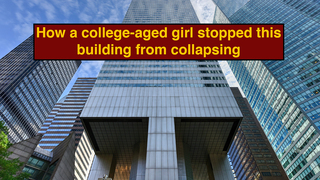An Architecture Student Once Stopped a New York City Skyscraper from Collapsing during a Hurricane

Who run the world, er, at least saved a good chunk of New York City's Manhattan island from disaster in the 70s? Girls. One college-aged girl, to be specific.
In 1978, a 59-story New York City skyscraper almost collapsed, potentially destroying 18 blocks in Manhattan's Midtown district. The catalyst in stopping this tragic disaster in its tracks? According to 99% Invisible, an undergraduate architecture student's thesis. Yep, you read that right; a student thesis managed to save Manhattan Island from a seemingly inevitable disaster.
When the Citicorp building (now known as 601 Lexington) was constructed one year earlier 1977, it was the seventh tallest building in the world (the '70s equivalent of the Guangzhou CTF Finance Center), and commonly noted for its innovative design, which included a 45-degree angled top, and the trait that almost brought down an entire NYC neighborhood -- the fact that it is essentially built on stilts. At one point, the bottom nine stories of the world's seventh-tallest building were resting on a pair of what more or less were stilts. Very reassuring!
Don't Miss
This, um, unique design choice came from a deal Citicorp struck with St. Peter's Lutheran Church, located on the corner of the property. They refused to move, Carl from Up style, but said the group could still build the skyscraper in the airspace above their church, provided they didn't touch their little corner. Seems pretty reasonable.
So how exactly did they manage to construct the building within those parameters? Well, the idea for the design first hit the project's chief structural engineer, William LeMessurier, while he was doodling on a napkin at a Greek restaurant (nothing like flaming saganaki to help light your creativity on fire). Instead of putting stilts on the corners of the building, they'd place them in the center, compensating with, among other features, a chevron bracing structure. As the chevron skeleton made the building particularly light for a skyscraper, meaning it would sway in the wind, LeMessurier added a 400-ton tuned mass damper to help prevent this from happening. While to any of us who don't know architecture, and evidently some people that did very well, this may all sound legit, but it turns out it actually wasn't.
A year after the building's completion in 1978, LeMessurier received a phone call from a young undergraduate architecture student named Diane Hartley, who had a rather bold claim -- the Citicorp building could topple over in the wind. After studying the structure as a part of her thesis, Hartley, who, according to the Daily Mail, was anecdotally referred to as a man for many years, found that the building was particularly vulnerable to quartering winds, which hit the corners of buildings.
While LeMessurier had done the math and found that his design held up against perpendicular winds, which hit buildings on their faces, he failed to account for quartering winds. After analyzing the speed of winds the building could withstand against weather data, he found something frightening -- a storm strong enough to knock over the Citicorp building hit Manhattan once every 55 years, if the tuned mass damper is up and running, which doesn't always happen in a blackout. So what does this mean? Each year the building was standing, it had a 1 in 16 chance of collapsing. Yikes.
Immediately, LeMessurier sprung to action, coordinating emergency repairs with Citicorp, working out an evacuation plan with the NYPD, and even had 2,500 members of the Red Cross on reserve in case the building fell -- all while Hurricane Ella fast approached the greater New York City area.
After hearing about all this madness, one would think this story would be front-page news, captivating the globe and dominating the national conversation with the compelling story of the tragedy that wasn't. You'd be entirely wrong. Hurricane Ella never made landfall, meaning that NYC residents, including the building's tenants, had no idea this ever happened -- at least for 17 years, until loose lips sunk ships, er, in this case, spilled the story of how a major skyscraper almost collapsed in the '70s.
In 1995, famed film critic, Joe Morgenstern says he overheard the story being told at a party and managed to convince LeMessurier to partake in an interview, ultimately breaking the news in The New Yorker in May of that year.
Yet through it all, Hartley had no idea she was a hero, that her work saved countless lives until she watched a BBC documentary on the subject in the 2000s. In short? Heroes don't always wear capes; sometimes, they just have a really good understanding of architecture.
To read about college-aged-ish woman who, unlike Hartley, has zero understanding of architecture, follow Carly on Instagram @HuntressThompson and on Twitter @TennesAnyone.